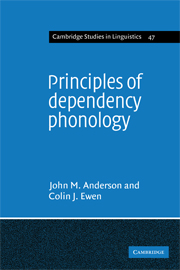8 - Conclusions and consequences
Published online by Cambridge University Press: 04 August 2010
Summary
We do not provide here (any more than in chapter 7) a detailed account of the conclusions that may be drawn from the preceding discussions. On the one hand, this would in many instances merely repeat concluding statements to other sections, chapters or parts. On the other, the firmness with which different individual conclusions may be drawn is variable, and best assessed in the context of specific discussions. However, we should like to state and elaborate upon some general conclusions. Furthermore, it is also possible at this point to examine some of the consequences of adopting the notation argued for here, consequences which it was inappropriate to introduce in the course of the preceding discussion but whose validity provides significant ‘external’ support to the argument.
Most notable, it seems to us, are consequences concerning: (a) our view of linguistic representation in general, and (b) non-notational aspects of the phonology, particularly its organisation. Both sets of consequences are associated with our general contention that phonological representations, both suprasegmental and infrasegmental, are more highly structured, and display more structural variables, than the matrix representation of ‘classical’ feature phonology. They are associated also with our more specific contention that many of these structural properties are most appropriately modelled by representations incorporating the dependency relation.
We have argued that suprasegmental structure, both at the lexical and at the utterance level, involves a fixed hierarchy of constructions which are individually identified by their place in this hierarchy and by the direction of modification associated with them.
- Type
- Chapter
- Information
- Principles of Dependency Phonology , pp. 281 - 296Publisher: Cambridge University PressPrint publication year: 1987



